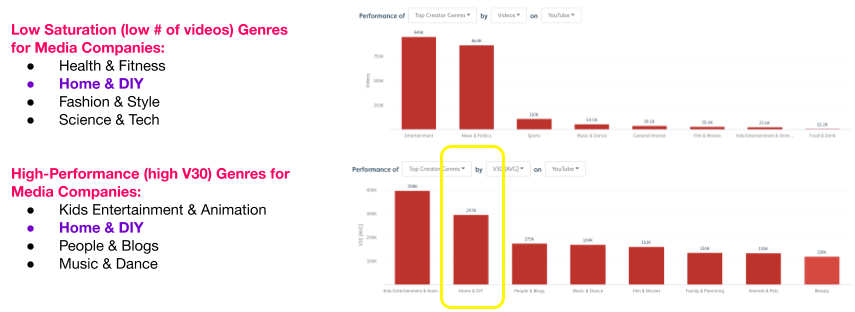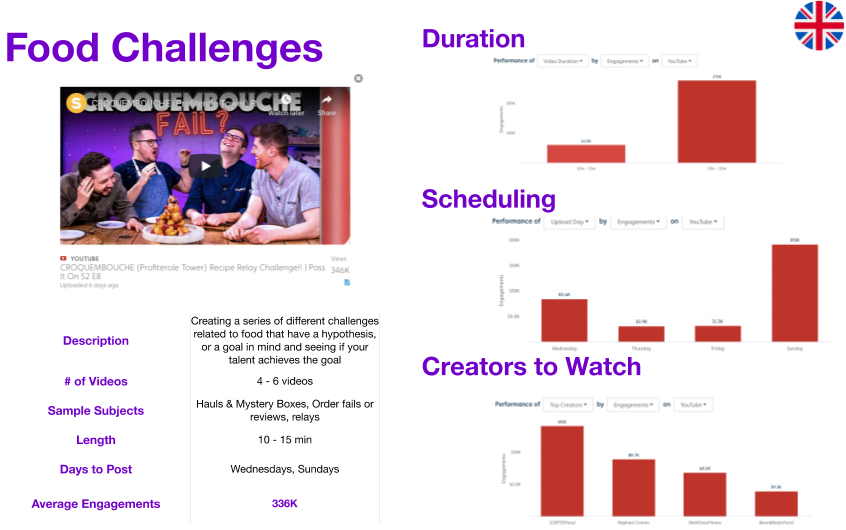Creating a video content strategy is nothing short of daunting.
As a content strategist, you’re tasked with figuring out the best content to deliver to your audience to create financial and brand results for your company. Unfortunately, you have some key problems:
- You don’t know what category of content to create: With so many content options and topics available, where are you supposed to start and why?
- You don’t know how much content to create: How often should you make and release this content to effectively manage your time and resources?
- You don’t know how to optimize content for format, length, tone, etc.: What kinds of patterns or themes seem to work well to save my team time and effort?
- You don’t know how to pitch your creative and production teams: How do you present the data you found to your creative team in a helpful way?
- You don’t know how to operationalize your video strategy into a production calendar: What’s the best way to set up a clear, concise calendar so everyone is on the same page?
However, with the right framework, you can incorporate insights of what the world is watching into a well thought-out, effective content plan.
Let’s go over your content challenges and give you a framework to find the answers you need!
You don’t know what category of content to create.
To figure out what content you should create that will see the most success, it’s extremely important to understand market demand, i.e. what content categories a lot of people are watching but where not a lot of videos live.
- Set your criteria to find which genre or categories have a high performance and a low number of videos (high demand, low supply).
- Example: Fewer Home & DIY content has been uploaded to YouTube recently, but the genre consistently pulls in high average views. As such, consider developing more content for this category.

You don’t know how much content to create for your video content strategy.
Jumping straight into creating content is not advised, because you need to be able to effectively manage your time and your resources. Instead, look into how much content the top creators are making and use that to guide your own plan.
- Research the top creators in your chosen categories to see how much content in a given week they’re uploading so you can start to replicate that success.
- Example: Some of the top creators in the Home & DIY space on YouTube are uploading anywhere from 10-20 videos per week, while they’re uploading around 30-90 per week on Facebook.
You don’t know how to optimize content for format, length, tone, etc.
After figuring out what and how much content is best to make, now you have to determine what this content should look like. Do this by analyzing some of the most-watched and most-engaged videos in your chosen categories.
- Look at the top 20-40 videos in the genre you’re targeting to start identifying those top-performing themes or formats, watching as many of them as needed to pull out successful formats, styles/tone, length, upload day/time, etc. Grouping videos by common themes will allow you to understand overarching trends.
- Example: Across multiple Home & DIY videos that you watch, you find the top-performing ones are often compilations of hacks that also have a number in the title (i.e. “10 Amazing Camping Hacks”).

You don’t know how to pitch your creative and production teams.
When partnered effectively, data and creativity are the most powerful way to drive successful video content. As such, create a content slate your creative and production teams can choose from when looking to generate your video content strategy.
- Based on your research, develop a content slate of 5-10 different ideas, including video data and details that will help content teams make better decisions.
- Example: You present eight different popular formats in the Home & DIY category and the creative team picks two (hacks and tutorial) to begin generating content for.
You don’t know how to operationalize your video strategy into a production calendar.
You don’t want all of your hard work and wonderful data to go to waste, so you have to visualize these ideas to get buy-in from internal stakeholders. Construct a content calendar to inspire your creative and production teams into succeeding.
- Set up a content calendar with clear deadlines and an easy-to-read structure, with elements like color-coding and breaks in production for some breathing room.
- Example: Space out pre-production, production, and distribution as needed for your team, using colors like blue for in-progress and green for launch.
Here are some final suggestions as you work on your video content strategy:
- Test and iterate as you produce, publish, and release content. There are lots of factors that can drive an individual video’s success.
- Own concepts that don’t work and use them to reflect on how ideas can be refined.
- Think audience-first! Insight is the key to a healthy business. Understanding your audience’s interests and patterns will expedite growth.
Interested in seeing the data to power your content strategy and growing your audience?